|
"The navigators who fly
the regular routes use everything they can. They use celestial navigation, but
because there is 24-hour daylight they can use only one star, the sun." That's a
line from this "Kelly's Awful Airline" article in a 1965 issue of Popular
Mechanics magazine. It describes one of the many challenges facing the crew
of U.S. Navy Air Development Squadron Six's Commander George R. Kelly as they
perform many amazing feats of daring, skill, and ingenuity. In such an
unaccommodating environment as is the Antarctica, bravery and determination are
essential personal traits necessary for not just accomplishing goals, but for
basic survival. C-130s, C-47s, and what looks like a "Huey" (Bell UH-1) flew day
and night (although a lot of the time was 24-hour "day" due to being above the
Antarctic Circle), in temperatures that can nearly freeze gasoline and oil, not
to mention men's hands, feet, and faces. Few among us could or would do such
duty.
Kelly's Awful Airline

Flying the world's most hostile routes, tough polar crews boast a 5000-mile runway,
spinning compasses and survival practice at 50 below.
By Theodore Berland
The shrieks of the spinning, jet-powered props dropped to gentle whines, then
stopped silently. The forward door of the belly-low C-130 Hercules opened and a
smiling admiral stepped out onto a small red carpet that was spread on the blue
ice for the occasion.
He was followed by his aide, by other officials, and newsmen invited for the
trip. Hands snapped to salutes, then came down for shaking; flashbulbs popped and
shutters clicked.
Then the party of VIPs walked off toward heavy-tired vehicles that would transport
them three miles over frozen sea to McMurdo Station, headquarters base of the United
States in Antarctica.
Finally, almost unnoticed, out of the ski-shod airplane came the pilot. He had
just skippered the historic flight over the bottom of the world-nonstop from Cape
Town, South Africa, 4600 miles across the desolate ice seas and the white continent.
His record hop was the kind of operation that Cdr. George R. Kelly takes in stride.
It was simply another flight by the world's southernmost airline.
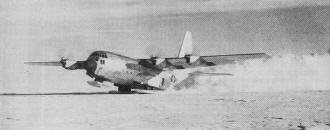
C-130 Hercules, plane that put "Antarctic Airlines" in business,
uses jato (jet-assisted takeoff) bottles for lifting heavy load at Byrd Station,
Antarctica
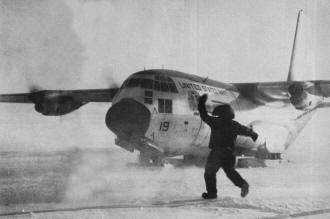
Ski-Equipped C-130 is nursed into parking position by arm-waving
Navy man at McMurdo Station. Skis are handy on Antarctica's "5000 miles of runways"
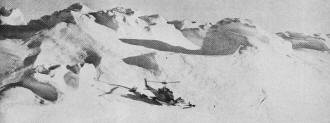
Stranded Helicopter awaits engine change on top of 9000-ft.
Mount Discovery. Summertime temperature: 20 degrees below zero! Helicopters, single-engine
Otters and twin-engine C-47s supplement workhorse C-130s in Antarctica
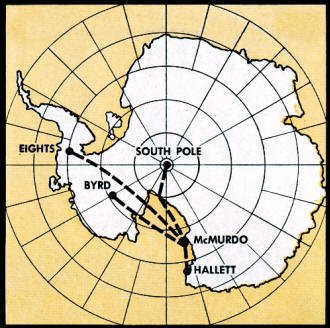
Antarctic Airlines' regular routes include flights from base
at McMurdo to Byrd, Eights, South Pole and Hollett Stations, round trips of up to
2700 miles
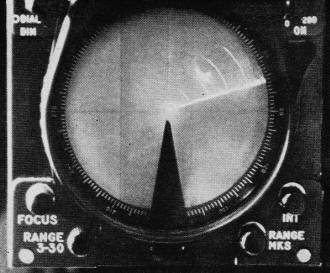
Radar Screen shows one of major landmarks, crevasse field called
The Jawbone. Radar is most reliable aid to navigation in South Pole's whiteness
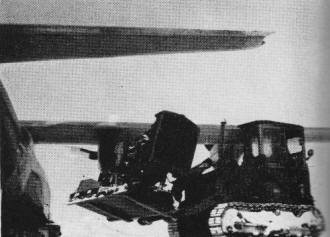
Heavy Cargo is major port of operations in Antarctica. Surface
vessels can bring it to shore, but only aircraft can transport it to inland bases
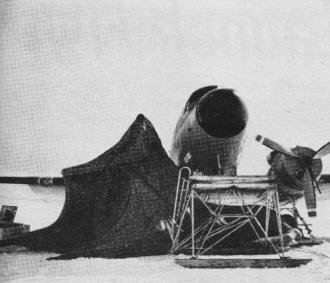
Discarded Parachute serves as windbreak for mechanics. Engine
prewarmer (left) pumps warm air inside so mechanics can work safely without gloves

Barehanded Crew does minor maintenance on C-47 engine. Without
warmed-up parachute tent, hands would stick to super-cold metal parts of plane
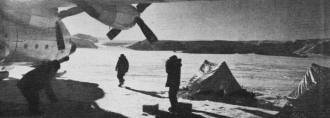
Another Chore is supplying field sites of scientific expeditions
such as those sponsored by National Science Foundation, on the ice cap. This site,
located in Pensacola Mountains area, conducts research in polar cold.
Commander Kelly heads the U.S. Navy's Air Development Squadron Six. Called VX-6
for short, it has a monopoly. It does all the flying for Americans and New Zealanders
at the world's last geographic frontier. And while it has no competition, it is
efficiently run, courageously operated and highly respected - in spite of the fact
that its nickname is Kelly's Awful Airline.
In many respects, VX-6 really is an airline. It has almost daily routes of delivery
- 1400 round-trip nautical miles from McMurdo's William Field to the South Pole
Station, 1600-n.m. round trip between McMurdo and Byrd Stations, and 2700-n.m. from
McMurdo to Eights Station.
That's the equivalent of flying out of Houston to Denver, to Tucson and to San
Francisco. And there are other irregular, nonscheduled flights in support of the
National Science Foundation's research assault at the bottom of the world.
VX-6 is a veritable supply lifeline to these isolated stations. Surface ships
led by icebreakers reach McMurdo during the southern summer (December). But the
men, fuel, food and equipment can only leave McMurdo via Kelly's aerial outfit.
The Navy flyboys put in grueling hours no civilian pilots' union would stand
for. "The average commercial pilot logs 75 hours a month," explains Kelly. "Our
pilots usually log 150 hours a month here, sometimes 200." More is demanded from
the machines, as well as the men. Where a civilian Gooney Bird (C-47) normally flies
at 26,000-pound gross weight, identical VX-6 planes gross 33,000 pounds.
In addition, flying in the Antarctic is flying in the most remote, minimally
mapped, hostile land on earth. To state the obvious, it's dangerous. Of the 29 Americans
who died on the continent up to 1963, 22 were killed in aircraft accidents.
VX-6 has been flying over the White Continent every season since 1955, when the
Navy began its support of our scientific efforts down there. The VX-6 of today,
however, is a radically changed outfit. And the degree of change is indicated in
its airline-type operation.
There are two reasons for the new look. One is the accumulation of experience
under unique flying conditions. The other is a unique airplane, the C-130 Hercules.
Built by Lockheed, it is called by Kelly and the other pilots "the airplane that
has revolutionized polar flying."
Four planes were put into the field during Deep Freeze '62. It wasn't long before
the C-130 became legendary.
The saga of Darbyville helped make the legend. On New Year's Day, 1962, in the
brightness of the southern summer evening, a lone C-130 was halfway from McMurdo
to Byrd Station when one of its slim propjets began to falter, then quit. The Hercules
simply lost a few thousand feet altitude and kept right on going.
Then the second engine sputtered and was feathered. Back in the cavernous body
of the transport, Chaplain August Mendonza and some of the crew were saying silent
prayers. Up on the flight deck, Marine Maj. Leslie L. Darbyshire and his copilot,
Navy Lt. Donald F. Moxley, looked over the ice desert below them with more than
a casual eye. They were picking the most likely looking level spots for an emergency
landing.
When the third engine began to falter, they decided it was time to go in. By
now they were 100 miles from Byrd. During the descent, the large rear door of the
scorpion-tailed plane was opened and its 20,000-pound load of steel drums of heating
oil was dumped. Darbyshire set up a landing pattern and brought the big aluminum
bird smoothly onto the ice.
Bringing the plane down was just one danger that had been passed. The crew and
its passengers were now stranded on a plateau of ice 8680 feet thick. They had to
survive in an area of the world where temperatures average -18° F. but can dip
to -82° F., where the land would provide nothing for survival but snow that
could be melted to water.
As soon as it could, a Search-and-Rescue crew took off from McMurdo in a jato-equipped
C-47. By the time it reached the downed C-130 it was greeted by a large sign stomped
in the snow proclaiming the site "Darbyville."
Panic to Picnic
After they landed, the rescue team expected to be greeted by half-frozen, starving
icemen. Instead, they were calmly ushered toward a row of red tents and white snow
huts. Inside one of the huts was a delicious smell - stew being cooked on portable
stoves, with the smoke carried out by a flue of empty oil cans.
Major Darbyshire and his men had set up a city. He had turned near-tragedy into
a survival exercise. He had averted disaster by proving that, with coolness in the
face of all that coldness, being downed in the Antarctic could be converted from
panic to picnic.
Mechanics from the rescue plane looked over the C-130 for the cause of the engine
failures. Their examination pointed to ice contaminating the fuel system.
Four days later, the C-130's engines were alive with power and it was skimming
over the ice, rising into the air, and homeward bound.
But there are other dangers on these bottom-of-the-world flights. One is the
whiteout - when the horizon and all shadows disappear as cloud cover and white landscape
merge into one.
During northern summers, at their Quonset Point, R.I., home base, VX-6 crews
practice the whiteout landing procedure. The pilot simply lowers skis and flaps,
reduces power and sets up a standard landing glide. Outside all is milky; inside
are the instruments, which become his senses. The pilot relies on only one of his
own, the feel of the skis touching and the shudder they impart to the plane.
Like any emergency procedure, however, it is never practiced enough. Caught in
a real Antarctic whiteout, a pilot felt his C-47 workhorse shudder, so he cut back
his engines. But the shudder was due to the plane's stalling - not a few feet off
the ice, but at 300 feet. The plane pancaked severely onto the ice. The crew walked
away, but left a total wreck behind.
Another C-47 pilot landed more properly in a whiteout, then waited for his air-speed
indicator to drop to zero. This would indicate that his plane had completely stopped.
After several minutes, however, air speed was still 30 knots.
The pilot asked his crew chief to open the back door and step down to see if
he could feel anything solid below them. The chief did, and stepped out. He almost
disappeared in five feet of snow on which the plane was resting. It was stopped
all right, but headed into a 30-knot wind.
Winter in Antarctica, contrariwise, is a blackout of perpetual night. It has
been pierced by a plane only once. A Seabee at McMurdo had fallen and broken his
back. He was paralyzed and in need of complete medical treatment. In an 11,000-mile
radiotelephone call, McMurdo's doctor, Lt. Thomas Bates, asked Rear Adm. James R.
Reedy at the Pentagon for help.
The admiral, who commands all naval support forces on the White Continent, relayed
the plea to VX-6. Almost immediately, two C-130s were on their way with a Navy doctor
and special surgical equipment. On landing at Christchurch, the pilots scrambled
for the operations office to check McMurdo's weather. It couldn't have been worse
- a blowing, whistling blizzard with no visibility.
After the planes were refueled, McMurdo weather was checked again. Visibility
had lifted to 10 miles. One of the propjets, flown by Lt. Robert V. Mayer, 40, was
soon airborne. On board was just enough fuel to come back, should weather close
in again.
Lit up Like Christmas
Luckily, it didn't. "The station was lit up like a Christmas tree," Mayer reported.
Oil drums and flares had been set up alongside the ice runway to pierce the blackout
and help the Hercules home in.
Wind is always devilish in Antarctica. On one helicopter flight to Cape Crozier,
a short hop across Ross Island, the winds at McMurdo station at one end of the island
were but 15 m.p.h. But at the Cape, they were an unexpected and howling 100 m.p.h.
The slow-flying helicopter was blown past the landing pad and out over the frozen
sea. Only with maximum power on the helo's engine, and after eight minutes, was
it able to inch back to Crozier.
Both the helicopters and the C-47s, plus a few one-engined Otters, do the special
short-haul jobs, like taking scientists and their instruments and equipment out
to remote glaciers, mountains and stations. They're perfect for hauling small loads
relatively short distances. And they are versatile. The helos, too, are veritable
mechanical acrobats. And that's fine for serving the scientists who sometimes have
the weirdest ideas.
Take the hair-raising "routine" flight of 30-year-old Lt. James Brandau.
"The other day," blonde-bearded Jim told me, "New Zealanders wanted to put a
surveyor's landmark on top of a mountain." He loaded them and their equipment aboard
his whirlybird and flew them out to the 2700-foot peak.
"The marker - which was really just three oil drums bolted together - had to
be right on the point and there was no place to land. I sidled the aircraft slowly
over to the peak until the right front gear touched. Then I hovered there, with
the left front gear and the rear wheel hanging in the air."
Hovering requires the engine to be at 80 percent power, so the scientists had
to be quick. The helicopter's side door was opened, and they stepped out onto the
steep icy peak. They pulled out the steel drums, secured them to the mountain top,
and climbed back in. Then the helicopter was off again.
Seals Picked Up
Specialty flying is the helicopter pilot's dish. Early this season, for instance,
they literally picked up six Weddell seals from the sea ice and carried them 10
miles back to McMurdo.
Not all flights are rosy. One helicopter flying a field party out of a deep desolate
valley carved between sheer cliffs had an engine failure. Lt. G. L. Maaske told
me how he set the craft down on Ferrar Glacier 60 miles from McMurdo. He and the
two scientists pitched a survival camp and cooked mulligan stew. In six hours an
Otter plane circled overhead, dropped crackers and jam, cigars and a magazine.
Then they were picked up and a six-man maintenance party, tools, food, and a
replacement engine were left behind. The mechanics worked and slept in the open
four days before the helicopter was fixed.
For big loads and long distances, the C-130 is the Kelly Airlines' workhorse.
Unlike the older P2V and the C-47, it can take off from unprepared ice without help;
jato is rarely used, and only for extra-heavy loads. Supplies are landed now; parachute
drops are obsolete.
The C-130 engines, being jets, require no prewarming. The plane carries its own
auxiliary power supply for engine starts, in the form of a small jet engine mounted
hidden inside the left landing gear well.
That's what Commander Kelly and the other pilots mean when they say the Hercules
has revolutionized Antarctic flying. And the tale of Darbyville proved, as one crew
member said, "that we have a 5000-mile runway here."
Even with these wonder planes, though, the problem of getting around is a formidable
one. There is no network of radio-navigation stations for constant bearing checks.
In fact, there are few fixed things upon which to check your position.
Further, the magnetic compass goes crazy and is unreliable near the Pole.
The navigators who fly the regular routes use everything they can. They use celestial
navigation, but because there is 24-hour daylight they can use only one star, the
sun. Each plane has a radar set and its navigator relies heavily on check points
he can pick up for a fix of his position or for determining his ground speed and
drift. Established mountain ranges and peaks are reliable; so, too, are giant crevasse
fields which have characteristic shapes on radar.
Abandoned crashed planes that poke above the snow drifts are also excellent landmarks,
especially for radar because metal reflects these waves best. That's one way newly
downed planes are located, too.
Abominable Snow Snake
But there always are unexplained exceptions. Like last November when a C-47 on
the way back from Byrd Station began losing oil from one engine-and altitude. After
dumping 350 gallons of fuel and 400 pounds of fresh eggs - that left a half-mile
yellow streak on the ice - the plane made an emergency landing. A companion C-47
landed beside it, picked up the crew and continued on to McMurdo.
The next day a plane loaded with mechanics flew out to where the downed plane
should have been. But they couldn't find it. On their return they reported, scratching
their heads, that "apparently white desert Arabs in white robes on white horses
simply stole it." Others said that the abominable snow snake had gulped it.
The men who fly Kelly's Awful Airline are full of such stories. But that's a
Navy characteristic. So, too, are guts and skill. The scientists who are squeezing
facts out of man's last geographical frontier have been successful, in part, because
they count on VX-6, and VX-6 stands behind its motto: "You Call, We Haul" - be it
on record runs or short heroic hops.
Posted July 20, 2024
|


